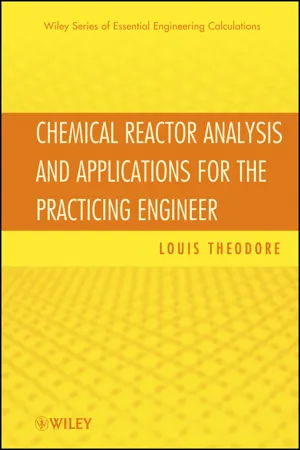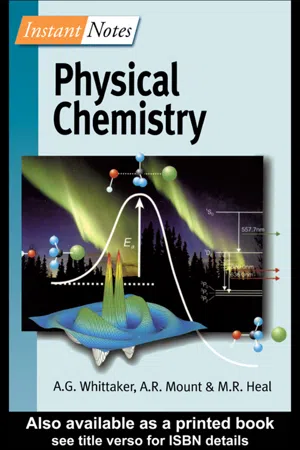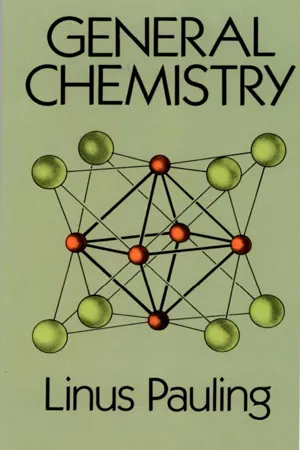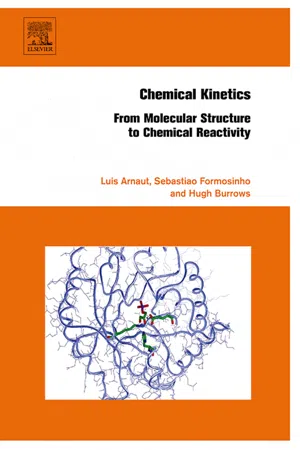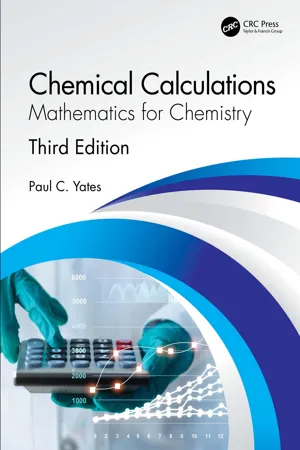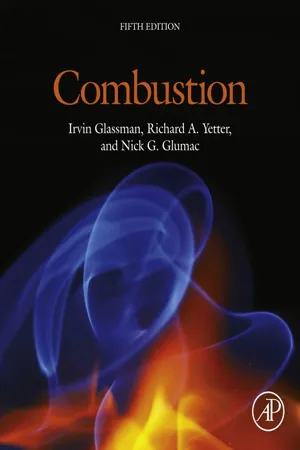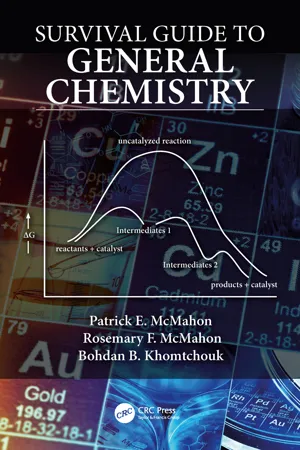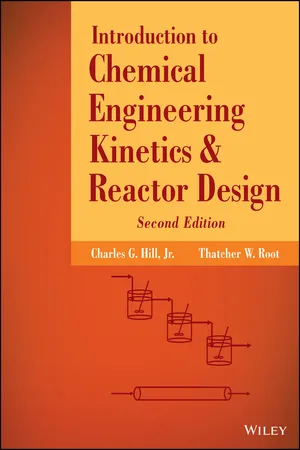Chemistry
Rate Constant
The rate constant is a proportionality constant that relates the rate of a chemical reaction to the concentrations of reactants. It is specific to a particular reaction at a given temperature and is used in the rate law equation to express the relationship between reactant concentrations and reaction rate. The value of the rate constant is influenced by temperature and the specific reaction mechanism.
Written by Perlego with AI-assistance
Related key terms
Related key terms
1 of 4
Related key terms
1 of 3
9 Key excerpts on "Rate Constant"
- Louis Theodore(Author)
- 2012(Publication Date)
- Wiley(Publisher)
The definition of the rate of reaction, the reaction velocity constant, and the order of reaction are presented. The variables affecting the rate are also discussed. This is followed by a section entitled “Rate vs Equilibrium Considerations.” The equations for many different types of reactions are developed in the third section. Particular emphasis is placed on notation, nomenclature, and units. The fourth section reviews the solution to numerous rate expressions. The chapter concludes with a section on the present day theories on reaction rates. Although many of the examples are presented in terms of species A, B, C, and so on, real systems are examined throughout the book in later chapters. REACTION RATES As noted earlier, chemical kinetics involves the study of reaction rates and the variables that affect these rates. It is a topic that is critical for the analysis of reacting systems. The rate of a chemical reaction can be described in any of several different ways. The most commonly used definition involves the time rate of change in the amount of one of the components participating in the reaction; this rate is also based on some arbitrary factor related to the reacting system’s size or geometry, such as volume, mass, or interfacial area. However, for homogeneous reactions, all reactants are present in a single phase. Some definitions for homogeneous reactions also require that the products appear in the same phase, which may be gaseous, liquid, or solid. A consistent and correct definition of the rate of a reaction is essential before meaningful kinetic and reactor applications can be discussed. The definitions found in most chemical kinetics and reactor kinetic texts, as well as the literature in these areas, often do not fit this description. As noted above, the rate of a chemical reaction can be described in any of several different ways. Use of the following definition is most convenient from an engineer’s point of view- eBook - ePub
- Gavin Whittaker, Andy Mount, Matthew Heal(Authors)
- 2000(Publication Date)
- Taylor & Francis(Publisher)
Fig. 3 The instantaneous rate of a reaction for a species is the slope of the tangent to the curve of concentration against time.Reactants and products may be consumed and formed at different rates according to the particular reaction stoichiometry (the numbers of molecules of reagent and products in the balanced chemical equation). For example, at any point in the reaction between hydrogen and nitrogen to form ammonia:the rate of consumption of hydrogen is three times the rate of consumption of nitrogen, whilst the rate of production of ammonia is twice the rate of consumption of nitrogen but only two-thirds the rate of consumption of hydrogen.Rate law
The rate law is the empirical relationship which describes the observed rate of reaction in terms of the concentrations of species in the overall reaction, including possibly the concentration of the products.It is often observed that the rate of reaction is proportional to the product of the individual concentrations of the reactants raised to a simple power, for example, rate ∝[A]α [B]β. Rate laws are empirical observations and do not necessarily fit the simple stoichiometry of the balanced chemical equation for the observed reaction but may be the consequence of a more complex underlying molecular reaction mechanism. For example, the apparently straightforward chemical reaction:has the experimentally determined rate law (see Topic F6 ):Rate Constants
Rate Constants , k , are the constants of proportionality which appear in the empirical rate law linking rate of reaction and concentration of species. The dimensions of the units of k are dependent on the formulation of the individual rate law but can always be derived by dimensional analysis of the rate law. Thus a reaction which is second order overall must have a Rate Constant with dimensions of concentration−1 .time−1 in order to provide the right hand side of the rate law with dimensions equal to the dimensions of concentrationtime1 for rate of reaction. The exact units of k depend on the units of concentration and time used, but mol dm−3 - eBook - ePub
- Linus Pauling(Author)
- 2014(Publication Date)
- Dover Publications(Publisher)
thermostat, which is held at a fixed temperature. The quantitative theory of reaction rate, discussed below, has special interest because of its relation to the theory of chemical equilibrium, which is treated in the following chapter.16-2. The Rate of a First-order Reaction at Constant Temperature
If a molecule, which we represent by the general symbol A, has a tendency to decompose spontaneously into smaller moleculesat a rate that is not influenced by the presence of other molecules, we expect that the number of molecules that decompose by such a unimolecular process in unit time will be proportional to the number present. If the volume of the system remains constant, the concentration of A will decrease at a rate proportional to this concentration. The symbol [A] represents the concentration of A (in moles per liter). The rate of decrease in concentration with time is—d [A]/dt. For a unimolecular decomposition we accordingly may write the equationas the differential equation determining the rate of the reaction. The factor k is called the first-order Rate Constant. A reaction of this kind is called a first-order reaction ; the order of a reaction is the sum of the powers of the concentration factors in the rate expression (on the right side of the rate equation).For example, the Rate Constant k may have the value 0.001, with the time t measured in seconds. The equation would then state that during each second 1/1000 of the molecules present would decompose. Suppose that at the time t = 0 there were 1,000,000,000 molecules per milliliter in the reaction vessel. During the first second 0.1% of these molecules would decompose, and there would remain at t = 1 second only 999,000,000 molecules undecomposed. During the next second 999,000 molecules would decompose, and there would remain 998,001,000 molecules.* - No longer available |Learn more
- Steven Boone, Drew H. Wolfe(Authors)
- 2011(Publication Date)
- Collins Reference(Publisher)
CHAPTER 14Rates of Chemical Reactions
C hemical kinetics , also called reaction kinetics , is the study of the rates of chemical reactions and the underlying mechanisms by which reactants change to products. An important outcome for studying the rates of chemical reactions is to develop an understanding of how chemical reactions take place. Chemists attempt to identify the molecular events that occur as reactants change to products. The series of steps that take place in a reaction is termed the reaction mechanism .14.1 RATES OF CHEMICAL REACTIONSThe enthalpy and entropy change in a chemical reaction is used to predict the spontaneity of the reaction (see Chapter 18), however, it provides no information regarding how long the reaction will take to reach completion, which is kinetics.Reaction RatesA rate refers to a change that occurs over a time interval. Chemical reaction rates may be monitored by measuring the change in concentration or pressure of a reactant or product over a time interval. Recall that the Greek letter delta, Δ, is used to represent a change. Therefore, this expression may be represented as follows.Exercise 14.1Consider the rate of the gas-phase reaction when nitrosyl fluoride, ONF, forms from F2 and NO.F2 (g) + 2NO(g) → 2ONF(g)(a) Write an expression that shows the rate of formation of ONF. (b) What are the units of reaction rate? (c) Write an expression that shows the rate of disappearance of NO. (d) Write an expression that shows the relationship between the rate of formation of ONF and rate of disappearance of NO. (e) Write an expression that shows the relationship between the rates of disappearance of F2 - eBook - ePub
Chemical Kinetics
From Molecular Structure to Chemical Reactivity
- Luis Arnaut, Hugh Burrows(Authors)
- 2006(Publication Date)
- Elsevier Science(Publisher)
4Reaction Order and Rate Constants
Publisher Summary
This chapter discusses the rate laws for elementary reactions. The majority of kinetic processes involve more than one elementary step. The dependence of the rate of a chemical reaction upon the concentration of reactants is obtained experimentally. For any time instant, the reaction velocity can be calculated from the tangent to the curve of the variation of concentration of reactants or products as a function of time. Since the rate law may change during the course of a reaction, in principle this should be determined experimentally at various times of reaction, either to confirm that it is constant or to identify any changes. The determination of rates of reactions using this method of tangents is known as the differential method of determination of rate laws. Alternatively, descriptions of the time evolution of concentration can be obtained by mathematical integration of the kinetic laws rather than from the study of the variation of concentration with time. However, the fact that a mechanism is in agreement with the kinetic law does not mean that it is the correct mechanism for the reaction. The same kinetic law can, and frequently does, correspond to more than one possible mechanism. A mechanism is always a theoretical hypothesis of how a reaction occurs.4.1 RATES OF ELEMENTARY REACTIONS
The dependence of the rate of a chemical reaction upon the concentration of reactants must be obtained experimentally. For any time instant, the reaction velocity can be calculated from the tangent to the curve of the variation of concentration of reactants or products as a function of time. Since the rate law may change during the course of a reaction, in principle this should be determined experimentally at various times of reaction, either to confirm that it is constant or to identify any changes. However, although this is possible, such a procedure is very time consuming and is not normally used, except for the initial phase of the reaction. The determination of rates of reactions using this method of tangents is known as the differential method of determination of rate laws. - eBook - ePub
Chemical Calculations
Mathematics for Chemistry, Third Edition
- Paul C. Yates(Author)
- 2023(Publication Date)
- CRC Press(Publisher)
5 KineticsDOI: 10.4324/9781003299981-55.1 Introduction
In contrast to the thermodynamics discussed in Chapter 3 , the range of mathematical techniques required for a study of kinetics is somewhat smaller. We will make much use of a technique called integration, which is essentially the reverse of the differentiation process we have already met. Analysing the rates of reactions normally involves taking a derivative, which describes the rate of change of concentration with time, and then reversing the differentiation process to obtain the original function by integrating.5.2 Using a Rate Equation
For a chemical reaction between molecules A and B, the rate v of the reaction will be given by an equation of the formv = k[ A ]x[ B ]ywhere k is a constant known as the Rate Constant, which varies with temperature. [A] and [B] are the concentrations of A and B respectively, raised to respective powers x and y which are often, but not always, integers. The reaction is said to have order x with respect to A, order y with respect to B, and overall order x + y.Rate always has units of mol dm−3 s−1 ; since x and y take different values for different reactions it follows that k will also have different units for different reactions. Remember that units always need to be the same on either side of an equation.Worked Example 5.1 For the reaction2NO+( g )Cl→ 22 ( g )NOCl( g )the rate v is given by the equationv = k [ NO] 2[Cl 2]where k is the Rate Constant whose value is 3.84 × 10−4 dm6 mol−2 s−1 .- Calculate the rate when a vessel of volume 2.50 dm3 contains 4.00 mol of NO and 3.50 mol Cl2 .
- What is the effect on the rate if the amount of NO is halved?
CHEMICAL BACKGROUNDNitrosyl chloride, NOCl, can be found as an orange gas and is both toxic and corrosive. Its oxidizing properties lead to it being used as a bleaching agent in flour, and it can also be found in detergents. - eBook - ePub
- Irvin Glassman, Richard A. Yetter, Nick G. Glumac(Authors)
- 2014(Publication Date)
- Academic Press(Publisher)
2 ].2.2. Rates of Reactions and Their Temperature Dependence
All chemical reactions, whether of the hydrolysis, acid–base, or combustion type, take place at a definite rate and depend on the conditions of the system. The most important of these conditions are the concentration of the reactants, the temperature, radiation effects, and the presence of a catalyst or inhibitor. The rate of the reaction may be expressed in terms of the concentration of any of the reacting substances or of any reaction product; that is, the rate may be expressed as the rate of decrease of the concentration of a reactant or the rate of increase of a reaction product.A stoichiometric relation describing a one-step chemical reaction of arbitrary complexity can be represented by the equation [3 ,4 ]∑j = 1nν j ′M j⇄∑j = 1nν j ″M j(2.1)whereν j ′are the stoichiometric coefficients of the reactants,ν j ″are the stoichiometric coefficients of the products, M is an arbitrary specification of all chemical species, and n is the total number of species involved. If a species represented by Mj does not occur as a reactant or product, its ν j equals zero. Consider, as an example, the recombination of H atoms in the presence of H atoms, that is, the reactionH + H + H →H 2+ Hn = 2 ,M 1= H ,M 2=H 2;v 1 ′= 3 ,v 1 ″= 1 ,v 2 ″= 1The reason for following this complex notation will become apparent shortly. The law of mass action, which is confirmed experimentally, states that the rate of a chemical reaction, defined as RR - eBook - ePub
- Patrick E. McMahon, Rosemary McMahon, Bohdan Khomtchouk(Authors)
- 2019(Publication Date)
- CRC Press(Publisher)
In this case, the “barrier” (termed the “diffusion barrier”) simply represents the statistical probability that the appropriate molecules will collide with each other in the correct geometry to allow orbital overlap. Since rates of diffusion are proportional to temperature, bond formation through collision increases with increasing temperature.The resulting general conclusion is that the rates of all chemical reactions increase with increasing temperature.RELATIONSHIP BETWEEN RATE CONSTANT , TEMPERATURE, AND EAThe general rate expression is in the form rate = k [reactant 1]X [reactant 2]Y . Excluding the complication of gases, concentrations are essentially constant with temperature. Therefore, the relationship between rate, temperature, and activation energy must exist through the Rate Constant, k.1. Rates of all chemical reactions increase with increasing temperature.2. Rates of one-step chemical reactions are inversely proportional to the activation barrier, Ea. In multi-step reactions, rates are inversely proportional to the energy barrier of the slowest step (r.d.s.).Rates increase as Ea (activation energy) decreases.Rates decrease as Ea increases.The two relationships are summed up in the Arrhenius equation:k = A e−Ea/RT or (alternate form): ln (k) = −Ea/RT + ln AT = Temperature in Kelvin; R = 0.008314 kJ/Mole-K; e and ln represent the natural log function; A is a constant (called the pre-exponential factor).The mathematical directional trends for the equation follow the concepts stated: Ea is in the numerator of the term (–Ea/RT); as Ea increases the term (–Ea/RT) becomes a larger negative value, the value of k decreases. As Ea decreases, the term (–Ea/RT) becomes a smaller negative value, the value of k increases.Temperature is in the denominator of the term (–Ea/RT). As T decreases, the term (–Ea/RT) becomes a larger negative value, the value of k decreases. As T increases, the term (–Ea/RT) becomes a smaller negative value, the value of k increases.The constant “A” represents the maximum rate of the reaction, when all - Charles G. Hill, Thatcher W. Root(Authors)
- 2014(Publication Date)
- Wiley(Publisher)
In addition to spectrophotometric or spectroscopic measurements, there are a number of other optical measurements that can be used to monitor the course of various reactions. Among the optical properties that can be used for these studies are optical rotation, refractive indices, fluorescence, and colorimetry. There also are several electrical measurements that may be used for analysis of solutions under in situ conditions. Among the properties that may be measured are dielectric constants, electrical conductivity or resistivity, and the redox potential of solutions. These properties are easily measured with instrumentation that is readily interfaced to a computer for data acquisition and manipulation for analysis. However, most of these techniques should be used only after careful calibration and do not give better than 1% accuracy without unusual care in the experimental work.3.3 Techniques for the Interpretation of Kinetic Data
In Section 3.1 the mathematical expressions that result from integration of various reaction rate functions were discussed in some detail. Our present problem is the converse of that considered earlier (i.e., given data on the concentration of a reactant or product as a function of time, how does one proceed to determine the reaction rate expression?).Determination of the rate expression normally involves a two-step procedure. First, the concentration dependence is determined at a fixed temperature. Then the temperature dependence of the Rate Constants is evaluated to obtain a complete reaction rate expression. The form of this temperature dependence is given by equation (3.0.14), so our present problem reduces to that of determining the form of the concentration dependence and the value of the Rate Constant at the temperature of the experiment.Unfortunately, there is no completely general method of determining the reaction rate expression or even of determining the order of a reaction. Usually, one employs an iterative trial-and-error procedure based on intelligent guesses and past experience with similar systems. Very often the stoichiometry of the reaction and knowledge of whether the reaction is “reversible” or “irreversible” will suggest a form of the rate equation to try first. If this initial guess (hypothesis) is incorrect, the investigator may then try other forms that are suggested either by assumptions about the mechanism of the reaction or by the nature of the discrepancies between the data and the mathematical model employed in a previous trial. Each reaction presents a unique problem, and success in fitting a reaction rate expression to the experimental data depends on the ingenuity of the individual investigator.
Index pages curate the most relevant extracts from our library of academic textbooks. They’ve been created using an in-house natural language model (NLM), each adding context and meaning to key research topics.
Explore more topic indexes
Explore more topic indexes
1 of 6
Explore more topic indexes
1 of 4
